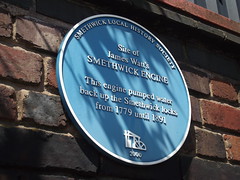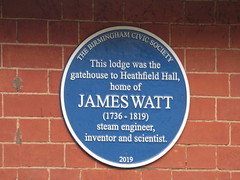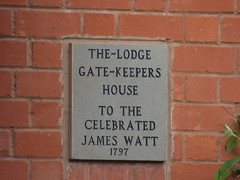James Watt


James Watt
(1736-1819)
Commemorated on 12 plaques
James Watt engineer, inventor and industrial pioneer lived here 1777-1790
Regent Street, Birmingham, United Kingdom where they lived (1776-1789)
Old Bess Engine. Power for the Industrial Revolution. In recognition of James Watt's improvements to the steam engine. 'Old Bess' was built by Boulton and Watt in 1777 and used to power their Soho Manufactory until 1848. this engine was the precursor of much of the power-generating plant on show in the Museum and is the oldest surviving of Watt's engines.
Science Museum, Exhibition Road, South Kensington, SW7, London, United Kingdom where they built (1776)
Boulton and Watt Engine The world's oldest steam engine still able to perform its original function. Presented to mark the year of the 250th anniversary of the birth of James Watt (Engineer) 1736-1819.
Crofton Pumping Station, Crofton, Marlborough, United Kingdom where they co-created this steam engine with Matthew Boulton
Boulton and Watt Engine The oldest rotative steam engine in the world. Built in 1785, it powered Whitbread's London Brewary until 1887. James Watt demonstrated this engine to King George III when he visited the brewary in 1787. This engine marks the start of mass industrialisation and the exponential increase in our use of fossil fuel.
Powerhouse Museum, 500 Harris Street, Ultimo, Sydney, New South Wales, Australia where they built (1784)
Site of James Watt's Smethwick Engine This engine pumped water back up the Smethwick locks from 1779 until 1891
Bridge Street North / Rolfe Street, Smethwick, United Kingdom where they designed
In Buchanan's land on this site James Watt occupied a workshop in 1763.
38 Trongate, G1 5ES, Glasgow, United Kingdom where they occupied a workshop (1762)
James Watt born 1736 - died 1819 this memorial building is erected on the site of his birthplace
William Street (junction with Dalrymple Street), Greenock, United Kingdom where they was born (1736)
Wattilisk sculpture by Vincent Woropay is presented. The sculpture is made of black Indian granite with an Egyptian obelisks and Native American totem poles which associate the surroundings and history of Birmingham, England. It has a surmounted portrait heads and is situated outside the Crown Courts. [full inscription unknown]
Queen Elizabeth II Law Courts - Birmingham Crown Court - Dalton Street, Birmingham, United Kingdom where they is commemorated
James Watt 1736-1819 Inventor of the Condensing Steam Engine Undertook his formative work in this building.
Kinneil Estate, Bo'ness, United Kingdom where they worked
This lodge was the gatehouse to Heathfield Hall, home of James Watt (1736 - 1819) steam engineer, inventor and scientist.
The Lodge - 33 Radnor Road, Handsworth, Birmingham, United Kingdom where they Lived here (1789-1818)
Near this spot in 1776 the first commercial steam engine to design of James Watt 1736-1819 was erected by Boulton and Watt to pump water from Bloomfield Colliery
Angle Ring Company, Bloomfield Road, Tipton, United Kingdom where they was
The-Lodge Gate-Keepers House to the celebrated James Watt 1797
The Lodge - 33 Radnor Road, Handsworth, Birmingham, United Kingdom where they lived near (1789-1818)







